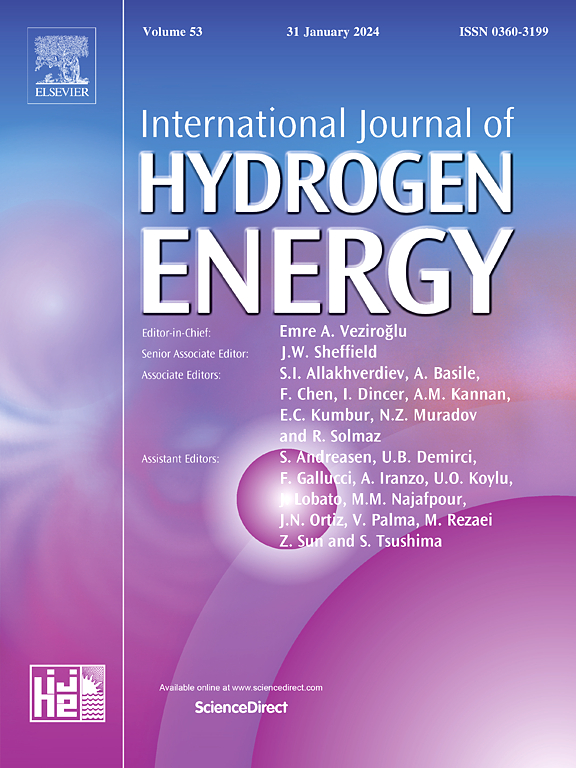PEM电解槽性能优化:基于田口的实验方法
IF 8.1
2区 工程技术
Q1 CHEMISTRY, PHYSICAL
引用次数: 0
摘要
在本研究中,研究了一个活性面积为9 cm2的质子交换膜(PEM)水电解槽在不同操作条件下的性能。阳极采用三层钛交叉网和纤维毡结构。根据Taguchi的实验设计,共进行了27项实验,研究了极端工作温度(40°C, 60°C, 80°C),夹紧扭矩(5 Nm, 7 Nm, 10 Nm)和水流速(10,20,30 mL/min)对氢气产生和电流密度的影响。从这些实验中可以看出,温度对反应动力学和膜电导率的影响最为显著。夹紧力矩改善了电极-膜接触,减少了内阻。水流速率对膜水合作用和气体去除有影响,尽管影响不大。三层网状结构,有效配水排气,降低过电压,运行平稳。在温度为80°C、扭矩为10 Nm、流速为10 mL/min时效果最佳。因此,研究结果强调了温度的主导作用,并表明在PEM电解槽设计中,夹紧力矩不仅应被视为机械因素,而且应被视为电化学活性设计因素。本文章由计算机程序翻译,如有差异,请以英文原文为准。

Performance optimization of PEM electrolyzers: An experimental and Taguchi-based approach
In this study, the performance of a proton exchange membrane (PEM) water electrolyzer with an active area of 9 cm2 was investigated under various operating conditions. At the anode, a three-layer titanium cross-mesh along with a fiber felt structure is employed. A total of twenty-seven experiments are conducted according to Taguchi's design of experiments to investigate extremes of operating temperature (40 °C, 60 °C, 80 °C), clamping torque (5 Nm, 7 Nm, 10 Nm), and water flow rates (10, 20, 30 mL/min) on hydrogen production and current density. From these experiments, it was noticed that temperature has the most notable influence by enhancing reaction kinetics and membrane conductivity. Clamping torque improves the electrode-membrane contacts and reduces internal resistance. Water flow rates have an effect on membrane hydration and gas removal, although somewhat less so. The three-layer mesh structure enables effective water distribution and gas evacuation, leading to lower overvoltage and steady operation. The best results came at 80 °C, torque of 10 Nm, and flow rate of 10 mL/min. Thus, the findings emphasize the dominant role of temperature and show that clamping torque should not only be regarded as a mechanical factor but also as an electrochemically active design factor in PEM electrolyzer design.
求助全文
通过发布文献求助,成功后即可免费获取论文全文。
去求助
来源期刊

International Journal of Hydrogen Energy
工程技术-环境科学
CiteScore
13.50
自引率
25.00%
发文量
3502
审稿时长
60 days
期刊介绍:
The objective of the International Journal of Hydrogen Energy is to facilitate the exchange of new ideas, technological advancements, and research findings in the field of Hydrogen Energy among scientists and engineers worldwide. This journal showcases original research, both analytical and experimental, covering various aspects of Hydrogen Energy. These include production, storage, transmission, utilization, enabling technologies, environmental impact, economic considerations, and global perspectives on hydrogen and its carriers such as NH3, CH4, alcohols, etc.
The utilization aspect encompasses various methods such as thermochemical (combustion), photochemical, electrochemical (fuel cells), and nuclear conversion of hydrogen, hydrogen isotopes, and hydrogen carriers into thermal, mechanical, and electrical energies. The applications of these energies can be found in transportation (including aerospace), industrial, commercial, and residential sectors.
 求助内容:
求助内容: 应助结果提醒方式:
应助结果提醒方式:


